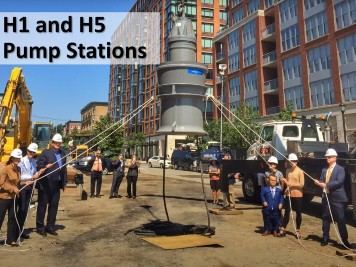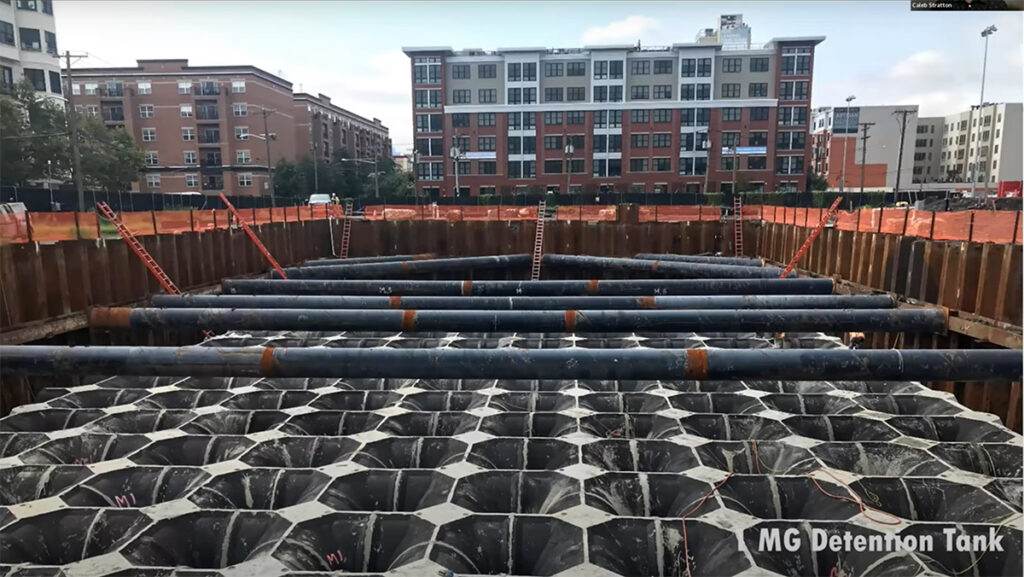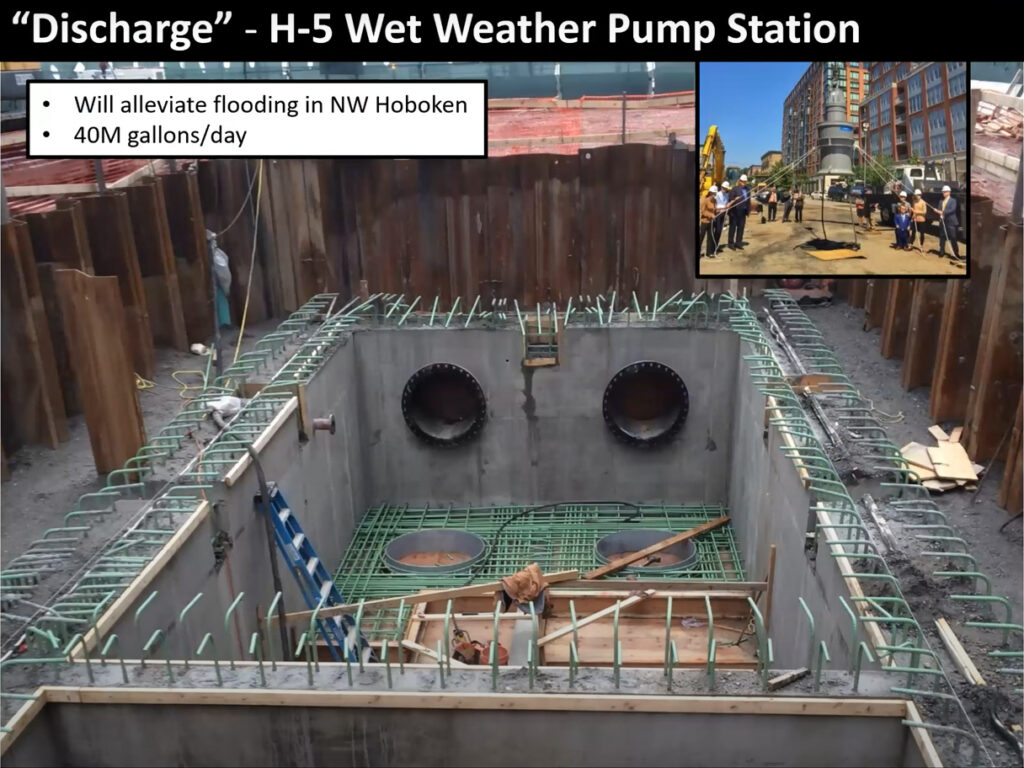A $392 million flood wall, now under construction, will protect against coastal storm surge; an additional $100 million has been invested in stormwater retention systems and high-velocity pumps to reduce flash flooding
FBW | April 1, 2024
FEMA’s flood maps, revised in 2013, show 75 percent of Hoboken’s land area to be in a high-hazard zone. Originally, Hoboken was like an island facing the Hudson River and surrounded by wetlands to the north and west.
In 2012, Mother Nature attempted to reclaim Hoboken’s low-lying former wetlands when Superstorm Sandy struck, putting much of the town under water and without power for nearly a week. Subsequently, the City of Hoboken began a concerted effort to develop a flood mitigation plan.
The City submitted a proposal to the federal Rebuild by Design program created in response to Superstorm Sandy. Hoboken was one of just ten applicants to be funded in the northeast United States. Working with a team that included Dutch engineers and planners, a comprehensive strategy was created, entitled Resist Delay Store Discharge.
The initial Rebuild by Design grant of $230 million was dedicated mostly for the Resist strategy, a flood wall that will protect Hoboken from a coastal storm surge like the one that occurred during Sandy. Construction of this wall has begun in north Hoboken and will extend into Weehawken. Building the flood wall involves pouring a steel-reinforced concrete base to undergird what is called a stem wall. (See images above.) The price tag for this work has grown considerably and now stands at $392 million. The New Jersey Department of Environmental Protection, which is managing this project, recently dedicated another $100 million to construct the Resist flood wall, $62 million short of the total cost.
The City of Hoboken has been forced to find other funding sources to implement the Delay Store Discharge part of the Rebuild by Design flood mitigation plan that addresses the frequent flooding that occurs during major rain storms. On March 21, Caleb Stratton, Hoboken’s Chief Resilience Officer, provided a detailed update on the Delay Store Discharge infrastructure improvements implemented over the past ten years. Rebuild by Design and One Architecture sponsored this webinar entitled “A Rainproofing Success? We Think So — Hoboken’s Approach.”
So far, the City has secured an estimated $100 million for Delay Store Discharge. Hoboken’s flooding problem has been exacerbated by its antiquated sewer system that combines sanitary waste and stormwater in a single pipe. The latest City project recently completed at Northwest Resiliency Park, in cooperation with the North Hudson Sewerage Authority, has separated these lines in the streets surrounding the park, installed a new high-velocity wet weather flood pump, and connected the stormwater pipe to a new sewer outfall at the Hudson River.
In 2011, after tropical storm Irene, the North Hudson Sewerage Authority installed a wet weather pump on Observer Highway at the foot of Washington Street with backup generators. This pump has the capacity to remove 2.08 million gallons of stormwater per hour. In 2016, an additional high-velocity pump costing $12 million was installed at 11th and Hudson Streets connected to a nearby sewer outfall at the Hudson River. This pump removes 1.67 million gallons per hour. The pumps are critical to moving flood waters from the low-lying areas of Hoboken, especially during high tide. These pumps, all maintained by the North Hudson Sewerage Authority, constitute the Discharge part of Rebuild by Design strategy.
The Delay Store component consists of a series of underground rainwater storage facilities as well as rain gardens, permeable surfaces and green roofs. The first underground retention system, built at Southwest Park, can store 200,000 gallons of stormwater. A second park at Seventh and Jackson Streets can store an additional 450,000 gallons. The storage capacity of Northwest Park is 2 million gallons. A storm dumping 3 or more inches of rain in an 8-hour period could dump over 50 million gallons of rainwater in Hoboken’s low-lying areas. The latest rain event on March 23 greatly exceeded the storage capacity built so far. In the webinar, Mr. Stratton stated that the infrastructure built thus far has reduced the extent of the flooding and substantially lessened the time required for flood waters to recede during these major storms but getting to 100 percent is proving difficult.
The Resist floodwall, which is consuming the bulk of the funding, will do nothing to protect against a major rain event, only a coastal storm surge. Superstorm Sandy was a surge event, pushing waters from the Atlantic Ocean into the New York Harbor, flooding coastal communities throughout the metropolitan area. A recent study, Flood Hazard Assessment for New York Harbor, determined that the surge level experienced during Sandy was a relatively rare event, not experienced since the 1700s. Construction of the floodwall, which extends to Jersey City at the south end and to Weehawken at the north, began this past year.
After Sandy, the City of Hoboken amended its flood ordinances. New buildings in flood zones are now required to put residential units above what is called the Design Flood Elevation. The areas below can contain parking garages and retail space but must be floodproofed to withstand the intrusion of flood water with minimal impact. These projects may also be required to provide underground retention systems as well as green roofs.
The federal Rebuild by Design program was designed to create models for flood mitigation. The Hoboken model, of course, would only be available to communities able to raise the substantial sums of funding required to build the required infrastructure.
Related Webpages
Flood Hazard Assessment for New York Harbor
City of Hoboken Flood Mitigation
Related Links
Hoboken floods worsen as Ida, Henri put stormwater management strategies to the test
Rebuild by Design floodwalls would have had no impact on Friday’s flash flooding
New York City’s flood hazard maps found to be inaccurate; so what about Hoboken?
Sea level rise will put half of Hoboken underwater by the next century
Are Hoboken’s proposed floodwalls based on overstated risk of another Superstorm Sandy?
What are the best strategies for making Hoboken flood-resilient?
Walling off Hoboken’s waterfront meets fierce resistance
Dutch-led team: Resist, Delay, Store, Discharge: a comprehensive strategy for Hoboken
Are we devising flood remedies based on a 1,000 year storm?
79% of Hoboken falls into FEMA’s new flood zone!






